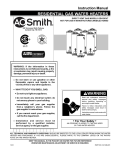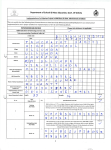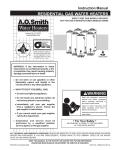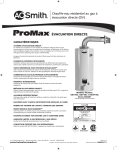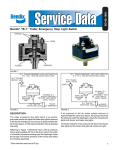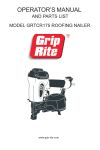Download Production of mechanical subassemblies by manual
Transcript
Promotion of TVET Viet Nam Mechatronics Vietnamese-German Development Cooperation Module Installation and Production of mechanical testing of pneumatic subassemblies by manual and electro-pneumatic production controls CDT06 MD MD 01 Promotion of TVET Viet Nam Publisher: Vietnamese-German Development Cooperation Promotion of TVET, Viet Nam General Directorate for Vocational Training (GDVT) 37 B Nguyen Binh Khiem Street Hanoi, Viet Nam Tel. +84 4 397 45 207 (Department of Administration and International Affairs) Fax +84 4 397 40 339 Deutsche Gesellschaft für Technische Zusammenarbeit (GTZ) GmbH 2nd Floor, No. 1, Alley 17, Ta Quang Buu Street Hanoi, Vietnam Tel: +84 4 397 46 571/-2 Fax: +84 4 397 46 570 Website: www.tvet-vietnam.org Author: Bernd Asmus, Pham Thanh Tung, Nguyen Phuc Dao, Phan Van Gian, Khuat Thanh Son, Ly Vu Son Translation: Pham Thanh Tung Design: Mariette Junk, Berlin Photo: Ralf Bäcker, Berlin Place and year of publishing: Hanoi, 2010 Promotion of TVET, Viet Nam Training module: Installation and testing of pneumatic and electro-pneumatic controls Code of Module: MD06 Time: 120 h. (Theory: 24h; Practice: 96h) I. Position and characteristics of the module - This module is built up from single projects (exercises), each of them developing and implementing a pneumatic or electro-pneumatic system or subsystem. - Every project is action orientated and carried out in such a way, that the trainee will be qualified for independent planning, conduction and checking of his work. - Every project is standing alone and contains as many objectives as possible but only a limited number of contents. - Starting with a real application the trainee has to analize the process, design the documentation and circuit diagrams, to mount and install the system, commission the system and do the trouble-shooting. - Before this module is implemented, the trainee should have basic skills in mechanical engineering, special in assembling technology, and electrical installation. II. Objectives of the module After finishing this module, the trainees are able to; - Develop the scheme of a mechatronic system in principle. - Read and apply technical documentations. - Solve problems systematically in a team. - Develop solutions for problems related to industrial processes and draw up in standardized diagrams. - Describe functions and applications of pneumatic and electric components in electropneumatic controls. - Read and draw up circuit diagrams for pneumatic and electro-pneumatic controls as solution for given applications. - Determine the work steps required for carrying out the mounting and installation of pneumatic and electro-pneumatic controls. - Select components, mount and install pneumatic and electro-pneumatic controls with laboratory and industrial components. - Measure, check and calculate electrical and pneumatic parameters. - Commission, operate and test pneumatic and electro-pneumatic controls. 1 Promotion of TVET, Viet Nam - Carry out systematic trouble-shooting and repair in pneumatic and electro-pneumatic controls, - Maintain and repair pneumatic and electro-pneumatic systems. - Read components-lists, assign designations to components and select components from catalogues. - Describe and follow safety regulations, particularly those arising from electrical power. - Communicate with partners (customers, suppliers and colleagues) - Develop readiness for self learning to improve knowledge and working skills. III. Contents of the module 1. Content overview and time allocation: No. 1 2 3 4 5 Duration Sum Theory Installation, operation and testing of 40 9 pneumatic system Design and installation of applied 8 2 pneumatic control system Installation, operation and testing of 40 8 electro-pneumatic system Design, installation and testing of 24 4 applied electro- pneumatic control system Error identification and Trouble 8 1 shooting of pneumatic, electropneumatic control system Name of lesson in the module Practice 28 Tests 3 6 0 30 2 16 4 6 1 2. Detailed contents: Lesson 1: Installation, operation and testing of pneumatic system Objectives: After finishing this lesson, the trainees are able to; (40h) - Develop the scheme of a mechatronic system in principle. - Solve problems systematically in a team - Develop solutions for problems related to industrial processes as group working result. - Draw up technical solutions in displacement-step or related diagrams - Describe functions and applications of components in pneumatic control systems. 2 Promotion of TVET, Viet Nam - Read and draw up pneumatic circuit diagrams - Install, operate and test pneumatic control system - Maintain and repair pneumatic system - Communicate with partners (customers, suppliers and colleagues) - Develop readiness for self learning to improve knowledge and working skills. Content: 1.1 Structure of control system 1.2 Solution of control problems in principle 1.3 Control of stack magazine with pneumatic cylinder 1.4 Automatic retraction of cylinder 1.5 Speed control of cylinder 1.6 Control with logic AND-function 1.7 Stack magazine with cylinder in extended end-position 1.8 Control with logic OR-function 1.9 Control with negation of signal 1.10 Feeding station – control with 2 cylinders 1.11 Sequence control with overlapping signals 1.12 Control with rotary dive 1.13 Control of changer module 1.14 Distribution station with single cycle 1.15 Distribution station with automatic 1.16 Pneumatic press with pressure-dependent control 1.17 Test, theory and practice Lesson 2: Design and installation of applied pneumatic control system- Pneumatic press Objectives: After finishing this lesson, the trainees are able to; (8h) - Draw up displacement-step and pneumatic circuit diagrams - Use technical documents - Describe function and application of industrial components used in pneumatic control systems - Read components-lists, assign designations to components and select components from catalogues. - Determine the work steps required for carrying out the mounting and installation. - Install, operate and test industrial pneumatic control system - Maintain and repair pneumatic system - Communicate with partners in order to find out general processing solution for technical assignment 3 Promotion of TVET, Viet Nam - Develop readiness for self learning to improve knowledge and working skills. Content: 2.1. Problem description 2.2. Pneumatic circuit diagram 2.3. Service unit 2.4. Selection of cylinders and accessories 2.5. Valve mounting on manifold 2.6. Selection of connectors 2.7. Selection of tubes 2.8. Detailed components list 2.9. Assembling of control 2.10. Commissioning and testing Lesson 3: Installation, operation and testing of electro-pneumatic system Objectives: After finishing this lesson, the trainees are able to; (40h) - Analyze and apply technical documents of electro-pneumatic components - Solve problems systematically in a team. - Develop solutions for problems related to industrial processes as group working result. - Draw up technical solutions in displacement-step or related diagrams. - Describe functions and applications of components in electro-pneumatic control systems. - Read and draw up pneumatic- and electric circuit diagrams. - Install, operate and test electro-pneumatic control system - Maintain and repair electro-pneumatic system - Communicate with partners (customers, suppliers and colleagues) - Develop readiness for self learning to improving knowledge and working skills. Content: 3.1. Control with double solenoid valve 3.2. Proximity sensing - Automatic retraction of cylinder 3.3. Proximity sensing with relay 3.4. Stack magazine with AND-function 3.5. Stack magazine with OR-function 3.6. Stack magazine with negation – Optical sensor 3.7. Stack magazine with single solenoid valve – Self locking control 3.8. Control with 2 cylinders 3.9. Control with 2 cylinders – Reading of electric circuit diagrams 3.10. Changer module with inductive sensing 4 Promotion of TVET, Viet Nam 3.11. Distribution station with single cycle 3.12. Test, theory and practice Lesson 4: Design, installation and testing of applied electro- pneumatic control system Objectives: After finishing this lesson, the trainees are able to; (24h) - Read and draw up electric-circuit-diagrams for electro-pneumatic controls. - Draw up terminal diagrams and assign contacts in circuit- and terminal diagrams. - Read and apply technical documents of electrical components used in industrial control systems. - Select industrial components for installation. - Describe functions and applications of components in electro-pneumatic control systems. - Determine the work steps required for carrying out the mounting and installation. - Mount electrical components on profile rails. - Determine the routing of wiring on basis of pre-determined end points. - Lay and fasten wiring in conduits and cable ducts - Trim wires ready for connection and attach to connection devices. - Install, operate and test applied electro-pneumatic control system - Identify components and connections - Maintain and repair electro- pneumatic system - Communicate with partners (customers, suppliers and colleagues) - Develop readiness for self learning for improving knowledge and working skills. Content: 4.1 Mounting and electrical installation of pneumatic press 4.2 Mounting and electrical installation of stack magazine 4.3 Mounting and electrical installation of changer module 4.4 Mounting and electrical installation of distribution station Lesson 5: Error identification and trouble shooting of pneumatic, electro-pneumatic control system Objectives: After finishing this lesson, the trainees are able to; (8 h) - Find faults by visual inspection - Read displacement-step-diagrams in order to determine the status of control in case of malfunction. 5 Promotion of TVET, Viet Nam - Measure and test pneumatic and electric values. - Identify faults in electric circuits by checking the current paths. - Eliminate faults by replacement and adjustment of components and rectification of connections in pneumatic and electro-pneumatic control system. - Commission and restart systems after trouble shooting. Content: 5.1 Methodology of error identification and trouble shooting 5.2 Practical exercises for trouble shooting 5.2.1 Faults in pneumatic part of system 5.2.2 Faults originated from wrong installation 5.2.3 Faults in running operating conditions 5.3 Test IV. Prerequisites for implementation of module • Pneumatic Lab: − For 12 to 16 trainees, always two trainees working at 1 working station − Size of room: min. 80m² − to 8 working stations − Power supply in cable duct round the lab. For every workstation 1 compressed air socket, 4x230V, 1 3-phase socket, 1 network socket − Control cabinet with fuses and emergency switch off − Working place for teacher with PC and printer − Blackboard, magnetic, min 2,5 x 1,2m − Overheadprojektor, Beamer and projection screen − Chairs and tables for theory and practice − Powerful compressor, extra silent − Storage cabinets for teaching aids and equipment. • Equipment of working stations (2 Schüler): − Computertable with PC − Working stattion with horizontal profile plate, trolley with drawers for components, mounting frame − Basic set of components for pneumatic − Basic set of components for electro-pneumatic − Set of pneumatic sub-stations (Magazine, pneumatic press, rotary drive, vacuum) − Set of industrial pneumatic components for assembling − Set of electrical components for electrical installation − Wiring board − Pneumatic components 6 Promotion of TVET, Viet Nam − Terminal strips − Electrical components (relays, lamps, switches) − Cable ducts, profile rail − Tool set, multimeter • Teaching media − Set of magnetic symbols pneumatic − Set of magnetic symbols electric − Software for design of circuits, demonstration of function of components V. Evaluation methods and contents of tests The evaluation of this modules contains: 1. Intermediate tests 1.1 Written examination pneumatic controls The trainee solves in max. 120min questions and exercises, multiple choice or essay questions, related to objectives and contents of the lesson “installation, operation and testing of pneumatic controls”. 1.2 Practical test pneumatic control The trainee installs in max 60min a pneumatic control according to given documentation and commissions this control. 1.3 Written examination electro-pneumatic controls The trainee solves in max. 120min questions and exercises, multiple choice or essay questions, related to objectives and contents of the lesson “installation, operation and testing of electro-pneumatic controls”. 2. Final examination 2.1 Written examination theory The trainee solves in max. 120min questions and exercises, related to objectives and contents of this module. 2.2 Examination work piece The trainee installs in max 120min an electro-pneumatic control with industrial components according to given documentation and commissions this control. 2.3 Working exercise The trainee conducts in max. 60 min a working exercise. The working exercise contains the trouble-shooting in an electro-pneumatic control with finding and repair of 1 or more faults. 7 Promotion of TVET, Viet Nam VI. Guide for implementation of the module • Fields of implementation of this module: − This module is used to qualify the trainees of vocational training programme at 2-year intermediate level for mechatronic trade on the level of skilled worker. − This module is a basic module, that could be also used to train: − mechatronic trade on college level − mechatronics at university level − trades in the field of mechanical engineering • Organization: − The lessons of this module should be organized in large blocks of at least one week up to 4 weeks duration to guarantee a steady work, especially in the practical parts. It is not practicable to interrupt the work of the students and use the components for assembling and installation for another group of students. • Some main guides in view of teaching methods for this module: − Before implementation of this module, the teaching staff should prepare all necessary prerequisites based on contents of individual lessons to ensure the teaching quality. − The teaching staff should guide the students to the ability to plan, execute and monitor their work independently. − The teaching staff should guide the students to independent problem solving. − All exercises should be focused on real situations, as they could take place in their future work in mechatronic trade. This means in particular that the exercises should mirror real industrial processes. − The teaching staff should instruct, give examples and correct errors while the trainees practice. − The teaching staff should use real industrial components and applications to implement the exercises. • Reference documents − Teaching and learning materials for module 06 " Installation and testing of pneumatic and electro-pneumatic controls", published by GTZ, TVET Vietnam 8 Promotion of TVET Viet Nam












